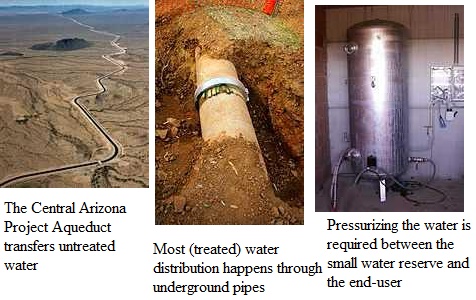Chapter: Environmental Engineering : Collection and conveyence System of water
Conveyance System: Significant

SIGNIFICANT
The product, delivered to the point of consumption, is called
fresh water if it receives little or no treatment, or drinking water if the
treatment achieves the water quality standards required for human consumption.
Once treated, chlorine is added to the water and it is
distributed by the local supply network. Today, water supply systems are
typically constructed of plastic, ferrous, or concrete circular pipe. However,
other "pipe" shapes and material may be used, such as square or
rectangular concrete boxes, arched brick pipe, or wood. Near the end point, the
network of pipes through which the water is delivered is often referred to as
the water mains.
The energy that the system needs to deliver the water is called
pressure. That energy is transferred to the water, therefore becoming water
pressure, in a number of ways: by a pump, by
gravity feed from a water source (such as a water tower) at a
higher elevation, or by compressed air.
The water is often transferred from a water reserve such as a
large communal reservoir before being transported to a more pressurized reserve
as a water tower.
In small domestic systems, the water may be pressurized by a
pressure vessel or even by an underground cistern (the latter however does need
additional pressurizing). This eliminates the need of a water-tower or any
other heightened water reserve to supply the water pressure.
These systems are
usually owned and maintained by local governments, such as cities, or other
public entities, but are occasionally operated by a commercial enterprise (see
water privatization). Water supply networks are part of the master planning of
communities, counties, and municipalities. Their planning and design requires
the expertise of city planners and civil engineers, who must consider many
factors, such as location, current demand, future growth, leakage, pressure,
pipe size, pressure loss, fire fighting flows, etc. - using pipe network
analysis and other tools. Constructioncomparable sewage systems, was one of the
great engineering advances that made urbanization possible. Improvement in the
quality of the water has been one of the great advances in public health.
As water passes through the distribution system, the water
quality can degrade by chemical reactions and biological processes. Corrosion
of metal pipe materials in the distribution system can cause the release of
metals into the water with undesirable aesthetic and health effects. Release of
iron from unlined iron pipes can result in customer reports of "red
water" at the tap . Release of copper from copper pipes can result in
customer reports of "blue water" and/or a metallic taste. Release of
lead can occur from the solder used to join copper pipe together or from brass
fixtures. Copper and lead levels at the consumer's tap are regulated to protect
consumer health.
Utilities will often adjust the chemistry of the water before
distribution to minimize its corrosiveness. The simplest adjustment involves control
of pH and alkalinity to produce a water that tends to passivate corrosion by
depositing a layer of calcium carbonate. Corrosion inhibitors are often added
to reduce release of metals into the water. Common corrosion inhibitors added
to the water are phosphates and silicates.
Maintenance of a
biologically safe drinking water is another goal in water distribution.
Typically, a chlorine based disinfectant, such as sodium hypochlorite or
monochloramine is added to the water as it leaves the treatment plant. Booster
stations can be placed within the distribution system to ensure that all areas
of the distribution system have adequate sustained levels of disinfection.
Related Topics